金融市场与金融机构 课后练习答案
最新《金融市场与金融机构》课后习题答案
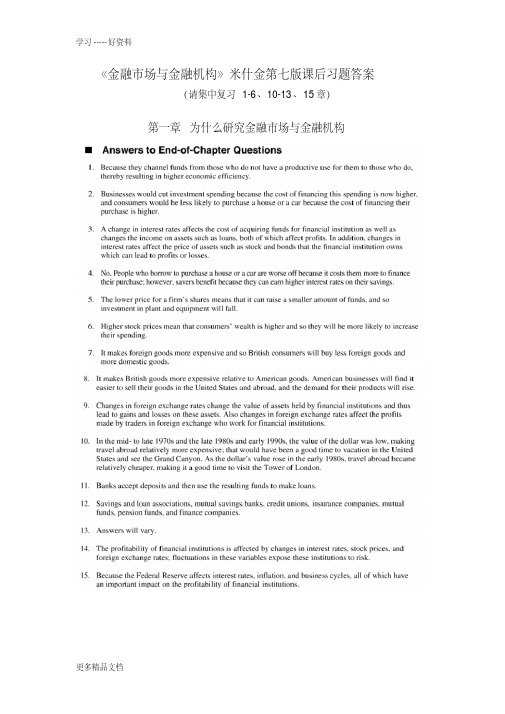
学习 ----- 好资料 更多精品文档
学习 ----- 好资料 更多精品文档
学习 ----- 好资料 更多精品文档
学习 ----- 好资料 更多精品文档
学习 ----- 好资料 更多精品文档
学习 ----- 好资料 更多精品文档
学习 ----- 好资料
第十五章 外汇市场
更多精品文档
学习 ----- 好资料 更多精品文档
学习 ----- 好资料 更多精品文档
学习 ----- 好资料 更多精品文档
学习 ----- 好资料 更多精品文档
学习 ----- 好资料
第四章 为什么利率会变化
更多精品文档
学习 ----- 好资料 更多精品文档
学习 ----- 好资料 更多精品文档
学习 ----- 好资料 更多精品文档
学习 ----- 好资料
《金融市场与金融机构》米什金第七版课后习题答案
(请集中复习 1-6 、10-13 、 15 章)
第一章 为什么研究金融市场与金融机构
更多精品文档
学习 ----- 好资料
第二章金融体系概览
更多精品文档
学习 ----- 好资料
第三章 利率的含义及其在定价中的作用
更多精品文档
学习 ----- 好资料 更多精品文档
学习 ----- 好资料 更多精品文档
学习 ----- 好资料 更多精品文档
学习 ----- 好资料 更多精品文档
学习 ----- 好资料
第五章 利率的风险结构和期限结构如何影响利率
更多精品文档
学习 ----- 好资料 更多精品文档
学习 ----- 好资料 更多精品文档
学习 ----- 好资料 更多精品文档
《金融市场与金融机构》课后习题答案之欧阳治创编
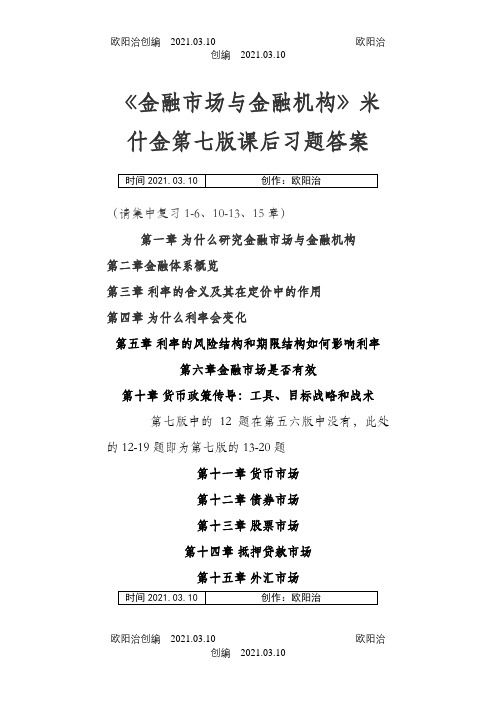
欧阳治创编 2021.03.10 欧阳治
创编 2021.03.10
《金融市场与金融机构》米什金第七版课后习题答案
(请集中复习1-6、10-13、15章)
第一章为什么研究金融市场与金融机构
第二章金融体系概览
第三章利率的含义及其在定价中的作用
第四章为什么利率会变化
第五章利率的风险结构和期限结构如何影响利率
第六章金融市场是否有效
第十章货币政策传导:工具、目标战略和战术第七版中的12题在第五六版中没有,此处的12-19题即为第七版的13-20题
第十一章货币市场
第十二章债券市场
第十三章股票市场
第十四章抵押贷款市场
第十五章外汇市场
欧阳治创编 2021.03.10 欧阳治
创编 2021.03.10。
《金融市场与金融机构》课后习题答案之欧阳与创编
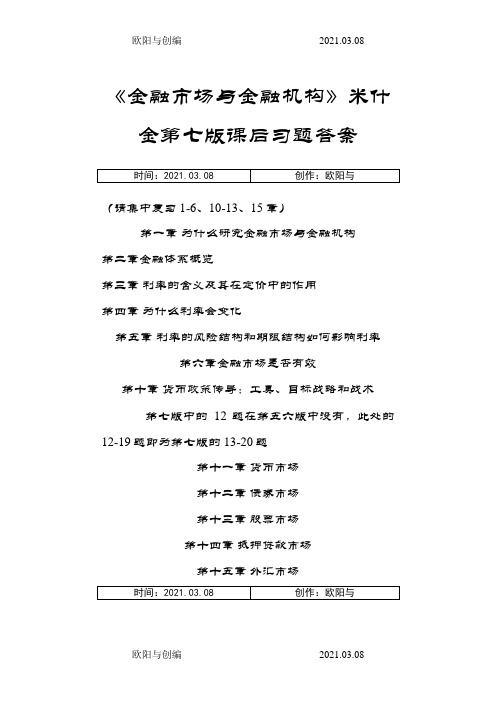
欧阳与创编 2021.03.08
欧阳与创编 2021.03.08 《金融市场与金融机构》米什
金第七版课后习题答案
(请集中复习1-6、10-13、15章)
第一章 为什么研究金融市场与金融机构
第二章金融体系概览
第三章 利率的含义及其在定价中的作用
第四章 为什么利率会变化
第五章 利率的风险结构和期限结构如何影响利率
第六章金融市场是否有效
第十章 货币政策传导:工具、目标战略和战术
第七版中的12题在第五六版中没有,此处的12-19题即为第七版的13-20题
第十一章 货币市场
第十二章 债券市场
第十三章 股票市场
第十四章 抵押贷款市场
第十五章
外汇市场。
《金融市场与金融机构》课后习题答案

《金融市场与金融机构》课后习题答案金融市场与金融机构金融市场与金融机构是当今社会经济发展中不可或缺的组成部分,它们之间相互依存、相互影响,共同促进着经济的繁荣与发展。
本文将回答一些关于金融市场与金融机构的习题,帮助读者更好地理解与运用相关知识。
第一部分:金融市场1. 金融市场的定义及作用金融市场是指各类金融工具发行、交易和流通的场所,包括货币市场、资本市场和衍生品市场等。
它的作用主要体现在以下几个方面:- 提供融资渠道:金融市场为各个经济主体提供了融资的渠道,满足了各类人群的融资需求,包括个人、企业、政府等。
- 资源配置功能:金融市场通过价格发现与信息传递机制,使得资源能够更加高效地配置到各个经济领域,促进资源的优化配置。
- 风险管理和避险功能:金融市场提供多种金融工具,使得市场参与者可以进行风险管理和避险,降低风险对经济的不利影响。
2. 货币市场与资本市场的区别货币市场是指短期金融工具的交易市场,包括短期国债、商业票据等。
它的特点主要有交易期限短、风险较低、流动性强等。
而资本市场是指长期资金融通的市场,包括股票市场和债券市场等。
资本市场的特点是交易期限长、风险较高、收益潜力大等。
3. 金融市场的参与者金融市场的参与者包括个人投资者、机构投资者和金融中介机构等。
个人投资者是指普通公众,他们通过购买金融产品来增加个人财富。
机构投资者指的是一些专业的投资机构,例如保险公司、养老基金等,他们通过交易金融产品来增加自己管理的资金的回报率。
金融中介机构包括银行、证券公司等,他们为个人投资者和机构投资者提供金融产品的交易和中介服务。
第二部分:金融机构1. 商业银行的功能与特点商业银行是金融机构中最为常见的一种形式,它的功能主要包括以下几个方面:- 存款业务:商业银行接受个人和企业的存款,提供储蓄、结算等服务。
- 贷款业务:商业银行向个人和企业提供贷款,满足其经济发展和消费需求。
- 外汇业务:商业银行提供外汇买卖和外汇汇款等服务,方便国际贸易和跨境资金流动。
最新金融市场与金融机构 (第七版 米什金) 课后练习答案

金融市场与金融机构第七版米什金课后练习答案第一章为什么研究金融市场和金融机构1、为什么金融市场对经济的健康运行很重要?答:因为金融市场将资金从无生产性用途一方转向有生产性用途一方来提高经济效率。
2、当利率上升时,公司和消费方的经济行为可能发生怎样的变化?答:当利率上升时,公司将减少投资消费,因为融资的成本现在比以前高。
而消费者将更愿意将资金放入融资机构以收取利息,而不愿意购买房屋和汽车。
3、利率变化如何影响金融机构的收益性?答:利率的变化将会影响金融机构获取资金的成本,也会影响资产的收益,如贷款;除此之外,利率的改变还会影响金融机构所持股票或债券的价格,会导致收益或损失。
4、当利率上升时,是否每个人的情况都变坏了?答:不会。
利率上升时,贷款购买房屋和汽车的消费者境况会变坏,因为利息提高而付出更多资金;但是对于存款人而言,他们的收益会因利息的提升而增加。
5、股票价格下跌对商业投资可能会有什么影响?答:股票下跌对企业来说将会使其获取的资金变少,会减少投资规模,如:延迟建造本应提供更多就业机会的新厂房,也会减少对新设备的购买。
6、股票价格上升对消费者的购买决策可能造成什么影响?答:股票价格上升对于股票持有者的消费者来说他的财富增加了,也会刺激他去扩大消费。
7、英镑价值下跌如何影响英国的消费者?答:英镑价值下跌意味着外国商品更昂贵,购买进口商品的成本更高,消费者将减少对外国商品的购买,而会增加对本国产品的消费。
8、英镑价值上升对美国的商业活动影响如何?答:英镑价值上升使英国商品相对美国商品而言更加昂贵,美国企业会发现其产品在国内和国外更畅销,其产品的购买需求增加。
9、汇率变化如何影响金融机构的赢利性?答:汇率的变化会改变金融机构所持资产的价格,如此改变其相关资产的收益和损失。
同时也会影响金融机构在进行外贸交易时的利润。
10、观察图1-3,你会选择哪些年份去亚利桑那州而不是伦敦旅游?答:在1970S的中晚期、80S的晚期、90S早期美元的汇率都比较低,出境旅游相对而言比较昂贵,但是国内游将是黄金时期,可以去看看大峡谷;在80S早期,美元的汇率升高,出境游比较划算,可以去看看伦敦塔。
(整理)米什金《金融市场与金融机构》课后习题答案
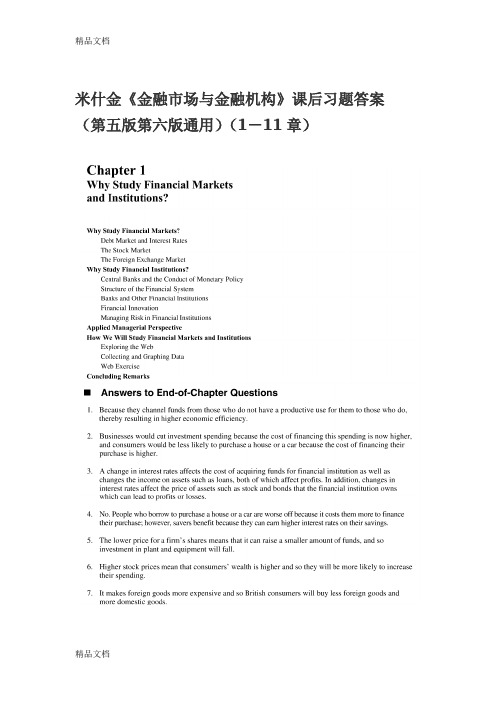
(第五版第六版通用)(1-11章)
(5)法律、行政法规和国务院规定的其他建设项目。
(4)跟踪评ห้องสมุดไป่ตู้的结论。
(二)环境影响经济损益分析的步骤
[答疑编号502334050102]
(4)建设项目环境保护措施及其技术、经济论证。
1.建设项目环境影响评价机构的资质管理
1.规划环境影响评价的技术依据
(1)内涵资产定价法
环境影响评价,是指对规划和建设项目实施后可能造成的环境影响进行分析、预测和评估,提出预防或者减轻不良环境影响的对策和措施,进行跟踪监测的方法和制度。
影响支付意愿的因素有:收入、替代品价格、年龄、教育、个人独特偏好以及对该环境物品的了解程度等。
《金融市场与金融的机构》课后习题答案
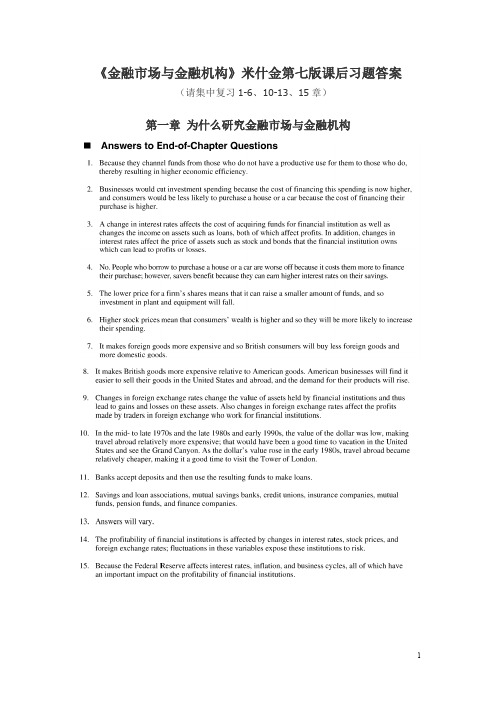
《金融市场与金融机构》米什金第七版课后习题答案
(请集中复习1-6、10-13、15章)
第一章为什么研究金融市场与金融机构
第二章金融体系概览
第三章利率的含义及其在定价中的作用
第四章为什么利率会变化
第五章利率的风险结构和期限结构如何影响利率
第六章金融市场是否有效
第十章货币政策传导:工具、目标战略和战术
第七版中的12题在第五六版中没有,此处的12-19题即为第七版的13-20题
第十一章货币市场
第十二章债券市场
第十三章股票市场
第十四章抵押贷款市场
第十五章外汇市场。
Fabozzi金融市场与金融机构基础课后答案

F a b o z z i金融市场与金融机构基础课后答案(总12页)--本页仅作为文档封面,使用时请直接删除即可----内页可以根据需求调整合适字体及大小--C H A P T E R6I N S U R A N C E C O M P A N I E STYPE OF INSURANCE COMPANIESInsurance companies sell insurance policies for a premium. They have two sources of income: underwriting income, and investment income.Life InsuranceThe life insurance company pays the beneficiary of the life insurance policy in the event of the death of the insured.Health InsuranceThe health insurance company pays the insured all or a portion of the medical treatment of the insured. Until the last decade, the major type of health insurance available was indemnity insurance. Due to the lack of constraints and incentives for cost savings, the medical service insured by indemnity insurance became very expensive. In response, various forms of managed health care have been developed. In general, these forms of managed health care put constraints on the choice of the provider by the insured and on the types of service provided by the provider.Property and Casualty InsuranceProperty and casualty (P&C) insurance companies insure the risk of damage to various types of property.Liability InsuranceThe risk insured against is litigation, or the risk of lawsuits against the insured due to actions by the insured or others. This is typically a third-party claim.Disability InsuranceDisability insurance insures against the inability of employed persons to earn an income. Typically, “own occ” disability insurance is written for professionals in white-collar occupations, and “any occ” for blue-collar workers. There are two types of policies regarding the sustainability of the policy. First, guaranteed renewable is a term where the issuer has to sustainthe policy for a specified period of time, but can change the premium rates for the entire class. The other type is noncancellable and guaranteed renewable whereby the issuer has no right to make any changes in any policy during the specified period.Long-Term Care InsuranceLong-term care insurance provides coverage for custodial care for the aged who are no longer able to care for themselves.Structured SettlementsStructured settlements are fixed, guaranteed periodic payments over a long period of time, typically resulting from a settlement on a disability policy or other type of policy.Investment Oriented ProductsA guaranteed investment contract or guaranteed income contract (or simply GIC), is a pure investment product. In a GIC, a life insurance company agrees, for a single premium, to pay the principal amount and a predetermined annual crediting rate over the life of the investment, all of which is paid at the maturity date. A life insurance company agrees in return for a premium to pay the principal amount and a predetermined annual crediting rate over the life of the investment. Effectively, a GIC is a zero coupon bond issued by a life insurance company and as such exposes the investor to the same credit risk. Some GICs require a single premium payment (bullet), others provide windows wherein deposits are accepted over time at the same interest rate. GICs are popular contracts for pension funds, since interest rate risk assumed by insurance company. But investors still have to worry about the credit risk of the insurance company.AnnuityAn annuity is often described as a mutual fund in an insurance wrapper. The income and realized gains are not taxable if not withdrawn from the annuity product. Thus, the “inside buildup” of returns receives a favorable tax treatment. Annuities can be either fixed, or variable. For a single payment or premium the insurance company will provide fixed payments for the life of the policyholder. It can also provide a “lump sum” payment to the retiree after a number of years of accumulating and investing premium payments.Monoline Insurance CompaniesMonoline insurers guarantee the timely repayment of the bond principal and interest when a bond insurer defaults on these payments. The insured securities have traditionally been municipal bonds, but they now includestructured finance bonds, CDOs, CLOs, and asset-backed bonds. Monoline insurers have been rated AAA and must have this high rating to be effective since they transfer their rating to the bond issue being insured.INSURANCE COMPANIES VERSUS TYPES OF PRODUCTSTraditionally, life and health products were coupled by an insurance company because of some of the similarities of the products. Property and casualty products were also provided by P&C companies. Companies that provide both types of insurances (life, health, property, casualty) are called multiline insurance companies. Investment products tend to be sold by life insurance companies.Recently, health insurance companies have separated from life insurance. This change has been due to mainly federal regulation of the health industry. Life insurance companies have focused on investment products. Also, disability insurance is now sold primarily by pure disability companies.FUNDAMENTALS OF INSURANCE INDUSTRYA fundamental aspect of the insurance industry results from the relationship between the revenues and costs. A company collects its premium income initially and invests these receipts in its portfolio. The payments on the insurance policy occur later and, depending on the type of insurance, in a perhaps very unpredictable manner. The payments are contingent on potential future events.An insurance policy is a binding contract for which the policyholder pays premium in exchange for the insurance company’s promise to pay specified amounts contingent on future events. The accepted policy is an asset for the owner and a liability for the insurance company.Life insurance and property and casualty insurance companies are financial intermediaries that, for a price, will make a payment if a certain event occurs. They function as risk bearers. The principal event that the life insurance company insures against is death: a life insurance company agrees to make either a lump sum payment to the beneficiary of the policy or make a series of payments. However, life insurance protection is not the only financial product sold by these companies. A major portion of the business of life insurance companies is now in the area of providing retirement benefits. The key distinction between life insurance and property and casualty insurance (P&C) companies is the difficulty of projecting whether a policyholder will be paid off and how much the payment will be.REGULATIONS OF INSURANCE INDUSTRYRegulation is primarily at the state level as a result of 1945 federal statute (McCarran-Ferguson Act). Model laws and regulations are developed by National Association of Insurance Commissioners(NAIC). Insurance companies are also rated by the rating agencies.To assure financial stability, insurance companies must maintain reserves or surplus, which are the excess of assets over liabilities. State statutory surplus requirements are called statutory surplus, which is distinguished from generally accepted accounting principles (GAAP) surplus.STRUCTURE OF INSURANCE COMPANIESInsurance companies are really a composite of three companies. First there is the “home office” or actual insurance company. Second, there is the investment component, which invests the premium collected in the investment portfolio. This is the investment company. The third is the distribution component of the sales force. There are different typed of distribution forces. Finally there are also brokers who sell insurance products of many companies.Insurance companies are attracted by commercial bank customer contacts. As a result, commercial bank distribution of insurance company products has grown. This relationship is called bankassurance.FORMS OF INSURANCE COMPANIESThere are two forms of insurance companies: stock and mutual. A stock insurance company is similar in structure to any corporation or public company. Shares (of ownership) are owned by independent shareholders and are traded publicly. The shareholders care only about the performance of their shares that is the stock appreciation and the dividends. The insurance policies are simply the products or business of the company. In contrast, mutual insurance companies have no stock and no external owners. Their policyholders are also their owners. The owners, that is the policyholders, care primarily or even solely about the performance on their insurance policies, notably the company’s ability to pay on the policy. Since theses payments may occur considerably into the future, the policyholders view may be long term.Finally a new form of insurance company, which is a hybrid between a pure mutual and a pure stock company has been approved by some states and implemented by some insurance companies in these states since their introduction in 1996. This form is called a mutual holding company (MHC).INDIVIDUAL VERSUS GROUP INSURANCEInsurance products can be sold on individual and group bases. Also, in the P&C business, insurers can sell personal lines and commercial lines of insurance products.TYPES OF LIFE INSURANCEThere are two fundamentally different types of life insurance: term (life) insurance and cash value life insurance.Term InsuranceTerm policies pay off only on death. Three are no investment benefits and so the premiums are substantially lower than those on whole life policies. Most group policies are t erm policies. “Term” implies that coverage is available only during the premium-paying term of the contract.Cash Value or Permanent Life InsuranceThere is a broad classification of life insurance, which is cash value, or permanent or investment type life insurance. A common type of cash value life insurance is whole life insurance. This cash value can be withdrawn and can also be borrowed against by the owner of the policy. If the owner wishes to let the policy lapse, he or she can withdraw the cash value. A major advantage of this type of policy is that the inside buildup is not subject to tax, ., is taxed as either income or capital gains. Neither is the beneficiary subject to income tax.Guaranteed cash value life insurance:This insurance provides a cash value based on a minimum dividend paid on the policy. Additionally, the policy can be either participating or nonparticipating. For a nonparticipating policy, the minimum dividend and the minimum cash value on the policy are the guaranteed amounts. For the participating policy, the dividend paid on the policy is based on the realized actuarial experience of the company and its investment portfolio.Variable life insurance:Contrary to the guaranteed or fixed cash value policies based on the general account portfolio of the insurance company, variable life insurance policies allow the policy owner to, within limits, allocate their premium payments to and among separate investment accounts maintained by the insurance company. Variable life insurance, which typically has common stock investment options, has grown quickly with the stock market rally of the 1990’s.Flexible premium policies—universal life insurance:The key element of universal life is the flexibility of the premium. The policy cash value is set up as the cash value fund to which the investment income is credited and from which the cost of term insurance for the insured is debited. This separation of the cash value from the pure insurance is called the unbundling of the traditional life insurance policy.Variable universal life insurance: Variable universal life insurance combines the features of variable life and universal life policies, ., the choice of separate account investment products and flexible premiums.Survivorship (Second to Die) InsuranceAn added dimension of the whole life policies is that two people are jointly insured and the policy pays the death benefit not when the first person dies,but when the second person dies. This is called survivorship insurance or second-to-die insurance.GENERAL ACCOUNT AND SEPARATE ACCOUNT PRODUCTSThe general account of an insurance company refers to the investment portfolio of the overall company. Insurance companies must support the guaranteed performance of their general account products to the extent of their solvency. These are called general account products.Other types of insurance products receive no guarantee from the insurance company’s general account, and their performance is not based on the performance of the insurer’s general account but solely on the performance of an account separate from the general account of the insurer. These products are called separate account products.PARTICIPATING POLICIESThe performance of some general account products is not affected by the performance of the general account portfolio. The policy performance may not participate in the investment performance of the insurer’s general account investment portfolio. Such a policy is nonparticipating policy. Other general insurance products participate in the performance of the company’s general account performance. Such a policy is called a participating policy. Both stock and mutual insurance companies write both general and separate account products, but most participating general account products are written in mutual companies.INSURANCE COMPANIES INVESTMENT STRATEGIESIn general the characteristics of insurance company investment portfolio should reflect their liabilities - the insurance products they underwrite. There are many differences among the various types of insurance policies. Among them are:The expected time at which the average payment will be made by theinsurance company (Technically, the “duration” of the payments)The statistical or actuarial accuracy of estimatesOther factorsThe key distinction between life insurance, property and casualty insurance companies lies in the difficulty of projecting whether or not a policyholder will be paid off and how much the payment will be. There are also differences in investment strategy between public (or stock) and mutual insurance companies of the same type. The major difference is that stock companies tend to have less common stock than mutual companies.Most insurance company assets consist of debt, both public and private. In fact, life insurers as a group are the largest holders of bonds. Since life insurers are effectively taxed at very low rates, there are no advantages to holding municipals. The reason for bond holdings are (1) to match maturities, since liabilities are often long-term and at a fixed rate, and (2) regulations require that bonds be booked at cost, while stocks must be written at market value.CHANGES IN THE INSURANCE INDUSTRYThere have been three major types of changes in the insurance industry in the last two decades: (1) deregulation of the financial system; (2) internationalization of the insurance industry; (3) demutulization.Deregulation of the Financial SystemIn 1933, Congress passed the Glass-Steagall Act, which separated commercial banking, investment banking, and insurance. This act resulted in the breakup of the House of Morgan into separate investment banking and commercial banking entities. . On November 12, 1999 the Gramm-Leach-Bliley Act (GLB), called the Financial Modernization Act of 1999, was signed into law. This act removed the 50 year old “anti-affiliation restrictions” among commercial banks, investments banks and insurance companies. The passage of this act has eliminated the barriers between insurance companies, commercial banks, and investment banks and various combinations of these types of companies will continue to evolve. Since then, however, Citigroup sold its insurance business (Travelers) to MetLife, and no other major combinations between banking and insurance have taken place.Internationalization of the Insurance IndustryGlobalization has occurred in many industries, including insurance industry. With respect to the . globalization operates in two directions. First, . insurance companies have both acquired and entered into agreements with international insurance companies and begun operations in other countries. Second, international insurance companies, mainly European, have become even more active in acquiring . insurance and investment companies. The reasons are: (1) more rapid growth of the US financial business, (2) attractive demographics and income potential of the US market, and (3) less regulations.DemutualizationSince the mid-1990s, several insurance companies have changed from mutual to stock companies. Many industry observers believe that the recent demutualized insurance companies will either acquire other financial companies or will be acquired by other financial companies.EVOLUTION OF INSURANCE INVESTMENT AND RETIREMENT PRODUCTSEven prior to the Financial Modernization Act of 1999, there was an increasing overlap of insurance, investment and pension products and the distribution of those products. The passage of this Act has accelerated this convergence.Three decades ago there were three distinct types of products for individuals: insurance, savings/investment, and retirement. Retirement products include individual retirement accounts. During the last two decades, many productshave been developed that fit into two or even three of these categories. Products that are hybrid of retirement and investment products are 401k and Roth 401k.401(k) Plans and Roth 401(k) Plans401(k) plans are plans provided by an employer whereby an employee may elect to contribute pretax dollars to a qualified tax-deferred retirement plan.IRAs and Roth IRAsWhile a 401(k) is an employer-sponsored retirement program, the most common types of IRAs are personal tax-deferred retirement plans. Individually sponsored IRAs include traditional IRA, Roth IRA, and rollover IRA. Employer-sponsored IRA included Simplified Employee Pension (SEP) plans, and Savings Incentives Matching Plan for Employees (SIMPLE).ANSWERS TO QUESTIONS FOR CHAPTER 6(Questions are in bold print followed by answers.)1.a.What are the major sources of revenue for an insurance companyb.How are its profits determineda.An insurance company's revenue is generated from two sources: (1) premiumincome for policies written during the year; (2) investment income resulting from the investment of both the reserves established to pay off future claims and the P&C's surplus (asset less liabilities).b.Profit is determined by subtracting from the revenue for the year (asdefined above in question 1a) each of the following items: (1) claim expenses: funds that must be added to reserves for new claims for policies written during the year; (2) claim adjustment expenses: funds that must be added to reserves because of underestimates of actuarially projected claims from previous years; (3) taxes; (4) administrative and marketing expenses associated with issuing policies. If annual premiums exceed the sum of (1),(2) and (4), the difference is said to be the underwriting profit. Anunderwriting loss results otherwise.2. Name the major types of insurance and investment oriented products sold by insurance companies.The major types of insurance products sold are: Life insurance, Health insurance, Property and casualty insurance, Liability insurance, Disability insurance, long-term care insurance, GIC and annuities.3.a.What is a GICb.Does a GIC carry a “guarantee” like a government obligationa. A guaranteed investment contract (GIC) guarantees a fixed interest incomecompounded over the life of the contract. It is like a zero-coupon bond issued by an insurance company, usually to pension funds. A GIC shifts the interest rate risk from a pension fund to the issuer.b.The guarantee is given only by the insurance company. There is nogovernment bailout in case of insolvency of the issuer.4. What are some key differences between a mutual fund and an annuityIn a mutual fund, all income is taxable, and no guarantees are given in its performance. An annuity is an investment product often called a “mutual fund is in an insurance wrapper”. The wr apper is the guarantee by the insurance company. The company will pay the annuity holder.5. Why should a purchaser of life insurance be concerned about the credit rating of his or her insurance companyThe credit rating of an insurance company is extremely important to the purchaser of the LIC product. The credit risk of insurance company has been prominent by the default of several major issues of GIC . mutual Benefits and Executive Life in 1991.6.a.Does the SEC regulate all insurance companiesb.If not, who regulates thema.No. The insurance industry is regulated by individual states and only theSEC regulates those insurance companies whose stock is publicly traded.b.State laws and NAIC, a voluntary association of state insurancecommissioners.7. Does the insurance industry have a self-regulatory group and, if so, what is its roleModel laws and regulations are developed by the National Association of Insurance Commissioners (NAIC), a voluntary association of the state insurance commissioners, for application on insurance companies in all states. An adoption of a model law or regulation by the NAIC is not, however, binding on any state. States typically use these as a model when writing their own laws and regulations.8. What is the statutory surplus and why is it an important measure for an insurance companyFor an insurance company, surplus is simply total assets minus liabilities, or net worth. Due to state regulations the size of the surplus dictates the amount of common stock that an insurance company can hold and ultimately the amount of business it can write.9. What is bank assurance“Banc assurance” means combining the activities of banking and insurance companies. Several factors could explain the growing interest in banc assurance in certain regions: (1) deregulation and increased competition are forcing banking and insurance firms to seek new markets and products, (2) agrowth in savings, and (3) an increased demand for insurance with investment features.10.a.What is meant by “demutualization”b.What are the perceived advantages of demutualizationa.Demutualization refers to changing structure of insurance companies frombeing mutual companies stocks to ownership companies. This recent trend of demutualization in 1990’s is changing th e landscape of insurance industry.b.The advantages of demutualization is more competition, transparency andpressure for better performance for the shareholders.11. Comment on the following quotation from Frank J. Jones, “An Overview of Institutional Fix ed Income Strategies,” in Volume 1 of Professional Perspectives on Fixed Income Portfolio Management (Hoboken, NJ: John Wiley & Sons, 2000):An important impediment to the use of the total rate of return objective by stock life insurance companies is the role of equity analysts on WallStreet. . . . These equity analysts emphasize the stability of earnings and thereby prefer stable income to capital gains. Therefore, they consider only income and not capital gains, either realized or unrealized, in operating income—an important measure in their overall rating. While this practice of not considering capital gains may be appropriate for bonds, it certainly is inappropriate for common stock and provides a significant disincentive tolife insurance companies for owning common stock in their portfolios. . . . this equity analyst practice does a disservice to policyholders of stock life insurance companies since their insurance companies end up having inferior asset allocations.The statement by Jones has elements of subjective judgment and has several dimensions. It begs the merit of stocks vs. mutual structure of ownership and the respective rates of returns for the shareholders. It may be true that equity analysts emphasize the stability of earnings at the cost of capital gains. But those capital gains are reflected in the current price of the stock. It is up to the shareholders to realize those gains. Thus, the total rate of return objective by stock life insurance companies is not a real impediment.12. What are term insurance, whole life insurance, variable life insurance, universal life insurance, and survivorship insuranceTerm insurance is pure life. If the insured person dies while the policy is intact, the beneficiary receives the death benefit.Whole life insurance pays off a stated amount upon the death of the insured and accumulates a cash value that can be redeemed by the policyholder.Universal life pays a dividend that is tied to market interest rates. Essentially, the cash value of a universal life policy builds and is used to buy term insurance.Variable life insurance provides a death benefit that depends on the market value of the investment at the time of the insured’s death. The premiums are typically invested in common stock; hence such policies are referred to as equity-linked policies. While the death benefits are variable, there is a guaranteed minimum death benefit that the insurer agrees to pay regardless of the market value of the portfolio.Universal Life Insurance: the main element of the universal life insurance is the flexibility of premium for the policyholder. It separates term insurance from cash value element of the policy.13. Why are all participating policies written in an insurance company’s general accountAll participating policies by the insurance company are written in the general account. The general account of an insurance company refers to the investment portfolio of the overall company. Such products “Written by the company itself” are said to have a “general account guarantee” . they are a liability of the insurance company. The rating agencies provide a credit rating based on products written by or guaranteed by the general account.14. Whose liabilities are harder to predict, life insurers or property and casualty insurers Explain why.Property and casualty insurers P&Cs. Life insurance actuaries can predict death rates among various age groups based upon historical data. With P&Cs, the timing and amount of payoffs are almost random by nature. Past experience provides little predictive assistance. Homeowner claims are just as likely to arise in the first year of a policy or ten years later. Even then, the dollar amount of damage claims can be small or for the entire value of the policy.15. How does the Financial Modernization Act of 1999 affect the insurance industryThe Financial Modernization Act of 1999 will affect significantly the insurance industry in several ways. Even before this act, there was an increase overlap of insurance, investment, pension products and the distribution of products. The passage of this act has accelerated this convergence. This act has eliminated the barriers between insurance companies,commercial banks, and investment banks and various combinations will continue to evolve.。
金融市场的与金融的机构 (第七版 米什金) 课后练习答案

金融市场与金融机构第七版米什金课后练习答案第一章为什么研究金融市场和金融机构1、为什么金融市场对经济的健康运行很重要?答:因为金融市场将资金从无生产性用途一方转向有生产性用途一方来提高经济效率。
2、当利率上升时,公司和消费方的经济行为可能发生怎样的变化?答:当利率上升时,公司将减少投资消费,因为融资的成本现在比以前高。
而消费者将更愿意将资金放入融资机构以收取利息,而不愿意购买房屋和汽车。
3、利率变化如何影响金融机构的收益性?答:利率的变化将会影响金融机构获取资金的成本,也会影响资产的收益,如贷款;除此之外,利率的改变还会影响金融机构所持股票或债券的价格,会导致收益或损失。
4、当利率上升时,是否每个人的情况都变坏了?答:不会。
利率上升时,贷款购买房屋和汽车的消费者境况会变坏,因为利息提高而付出更多资金;但是对于存款人而言,他们的收益会因利息的提升而增加。
5、股票价格下跌对商业投资可能会有什么影响?答:股票下跌对企业来说将会使其获取的资金变少,会减少投资规模,如:延迟建造本应提供更多就业机会的新厂房,也会减少对新设备的购买。
6、股票价格上升对消费者的购买决策可能造成什么影响?答:股票价格上升对于股票持有者的消费者来说他的财富增加了,也会刺激他去扩大消费。
7、英镑价值下跌如何影响英国的消费者?答:英镑价值下跌意味着外国商品更昂贵,购买进口商品的成本更高,消费者将减少对外国商品的购买,而会增加对本国产品的消费。
8、英镑价值上升对美国的商业活动影响如何?答:英镑价值上升使英国商品相对美国商品而言更加昂贵,美国企业会发现其产品在国内和国外更畅销,其产品的购买需求增加。
9、汇率变化如何影响金融机构的赢利性?答:汇率的变化会改变金融机构所持资产的价格,如此改变其相关资产的收益和损失。
同时也会影响金融机构在进行外贸交易时的利润。
10、观察图1-3,你会选择哪些年份去亚利桑那州而不是伦敦旅游?答:在1970S的中晚期、80S的晚期、90S早期美元的汇率都比较低,出境旅游相对而言比较昂贵,但是国内游将是黄金时期,可以去看看大峡谷;在80S早期,美元的汇率升高,出境游比较划算,可以去看看伦敦塔。
- 1、下载文档前请自行甄别文档内容的完整性,平台不提供额外的编辑、内容补充、找答案等附加服务。
- 2、"仅部分预览"的文档,不可在线预览部分如存在完整性等问题,可反馈申请退款(可完整预览的文档不适用该条件!)。
- 3、如文档侵犯您的权益,请联系客服反馈,我们会尽快为您处理(人工客服工作时间:9:00-18:30)。
金融市场与金融机构第七版米什金课后练习答案第一章为什么研究金融市场和金融机构
1、为什么金融市场对经济的健康运行很重要
答:因为金融市场将资金从无生产性用途一方转向有生产性用途一方来提高经济效率。
2、当利率上升时,公司和消费方的经济行为可能发生怎样的变化
答:当利率上升时,公司将减少投资消费,因为融资的成本现在比以前高。
而消费者将更愿意将资金放入融资机构以收取利息,而不愿意购买房屋和汽车。
3、利率变化如何影响金融机构的收益性
答:利率的变化将会影响金融机构获取资金的成本,也会影响资产的收益,如贷款;除此之外,利率的改变还会影响金融机构所持股票或债券的价格,会导致收益或损失。
4、当利率上升时,是否每个人的情况都变坏了
答:不会。
利率上升时,贷款购买房屋和汽车的消费者境况会变坏,因为利息提高而付出更多资金;但是对于存款人而言,他们的收益会因利息的提升而增加。
5、股票价格下跌对商业投资可能会有什么影响
答:股票下跌对企业来说将会使其获取的资金变少,会减少投资规模,如:延迟建造本应提供更多就业机会的新厂房,也会减少对新设备的购买。
6、股票价格上升对消费者的购买决策可能造成什么影响
答:股票价格上升对于股票持有者的消费者来说他的财富增加了,也会刺激他去扩大消费。
7、英镑价值下跌如何影响英国的消费者
答:英镑价值下跌意味着外国商品更昂贵,购买进口商品的成本更高,消费者将减少对外国商品的购买,而会增加对本国产品的消费。
8、英镑价值上升对美国的商业活动影响如何
答:英镑价值上升使英国商品相对美国商品而言更加昂贵,美国企业会发现其产品在国内和国外更畅销,其产品的购买需求增加。
9、汇率变化如何影响金融机构的赢利性
答:汇率的变化会改变金融机构所持资产的价格,如此改变其相关资产的收益和损失。
同时也会影响金融机构在进行外贸交易时的利润。
10、观察图1-3,你会选择哪些年份去亚利桑那州而不是伦敦旅游
答:在1970S的中晚期、80S的晚期、90S早期美元的汇率都比较低,出境旅游相对而言比较昂贵,但是国内游将是黄金时期,可以去看看大峡谷;在80S早期,
美元的汇率升高,出境游比较划算,可以去看看伦敦塔。
11、银行的基本活动是什么
答:银行的基本活动是吸收存款和发放贷款。
12、除银行外,经济中的其他主要金融中介有哪些
答:还有储蓄和贷款社、互助储蓄银行、信用社、保险机构、互惠基金、养老基金和信贷公司。
13、在过去的10年中微信支付、支付宝支付、信用卡刷卡等使我们的生活变得更加方便,也可促进消费。
14、金融机构面临的风险有哪些类型
答:金融机构的收益性会受到利率的改变、股票的价格、汇率的改变而影响。
15、为什么金融机构的经理十分关心美联储的行为
答:因为美联储影响利率、通货膨胀和经济周期,而这些因素对金融机构的收益性有很大的影响。
计算题:04月25日最合适兑换成英镑,因为汇率为,200美元可换成英镑;04月07号最不合适兑换,因为汇率为,200美元可换成英镑;两者相差英镑。
